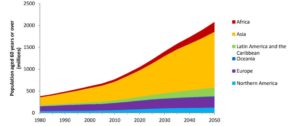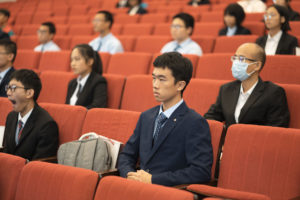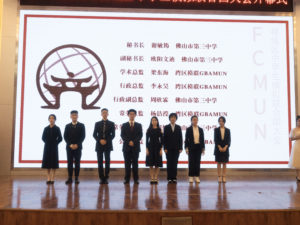Preface
Committee: General Assembly Third Committee: SOCHUM
Topic:Developing a sustainable labor market in aging countries
Representation: 50, Dual Delegation
Time Frame: Jan.2020
Language: English
The General Assembly allocates to the Third Committee, agenda items relating to a range of social, humanitarian affairs and human rights issues that affect people all over the world. Population aging—the increase of the share of older individuals in a society due to fertility declines and rising life expectancy—is an irreversible global trend with far-reaching economic and socio-political consequences. Considering labour market, an aging population is also an important source of rigidity, a factor that disrupts the good functioning of the labour markets. Under the condition of increasing competition and globalization, the rigidity becomes a matter of adapting to rapid economic changes. The impact of aging on the labour market is reflected in the negative impact on labour volume, diminishing economic resources needed to support older people, pressure on education systems, social and health insurance. In the short term, positive effects can be expected by reducing costs for pre and postnatal leaves, child benefits, healthcare, education, in the long term, however, increase the elderly dependency ratio. With the adoption of the 2030 Agenda for sustainable development, the international community has worked together for developing a sustainable labor market in aging countries. The Dais members sincerely look forward to meeting all of you in Chengdu this winter, with your thinking and passion to move forward into a better future.
Dais Head:
林奕佟 香港中文大学(深圳)
Nam Pham University of Toronto
Dais Members:
姚雯尉 University of Sydney
杨洁滢 暨南大学
张露云 重庆市第十一中学校
1.Definition of Key Terms
Aging population
Population aging refers to a shift in the distribution of a country’s population approaching older ages. This can be observed through an increase in the population’s mean and median ages, a rise in the proportion of the population composed of elderly, as well as a decline in the proportion of the population composed of children.
Unemployment
Unemployment means losing a job or not getting a chance to work. In general, there are two types of unemployment; involuntary unemployment and voluntary unemployment. However, economists are more focused on studying involuntary unemployment. Involuntary unemployment is when able-bodied people, who are actively searching for a job, can not find a job. Involuntary unemployment occurs due to the recession and restructuring, industries that change due to industrial restructuring, and joblessness in certain seasons.
Labour market
Labour economics aims to understand the dynamics and functioning of the markets for wage labour. Labour markets or job markets function to refer to markets where there is an interaction of workers and employers. In the labour market, employers strive to compete to hire the best, and workers also strive to compete for the best satisfying job. The labour market is highly competitive.
United Nation Development Programme (UNDP)
A subset of United Nation, the United Nations Development Programme is a global development network. Its main focus lies in advocating for change and connecting countries to knowledge, experience and resources to help a variety of people to live and build better lives for themselves.
Pension
A regular payment made during a person’s retirement from an investment fund to which that person or their employer has contributed during their working life.
2.Background Information
Decreasing population and aging are two of the most crucial characteristics of demography. All European Union countries face these problems with different intensities from one region to another. Every country from one region to another in the European Union faces these issues; each with different intensities.
Researchers intend to make an analysis of demographic conditions in different European countries to observe the effects that should be considered when we examine the relationship between increasing dependency ratio and social security systems, as well as occupational structure and long-term unemployment. Looking at the labour market, an aging population can be an important factor that disrupts the good functioning of the labour market. Under conditions such as increasing globalization and competition, this factor becomes a matter of adapting to rapid economic changes.
Demography represents an important aspect of socio-economic life, considering the aging and decreasing population prospects that affect different intensities in all European Union countries. An older population poses additional pressure on security social systems, over the pressure due to long term unemployment, as well as disadvantaged groups, etc. According to the International Conference on Applied Economics (ICOAE 2012), the dependency ratio has increased over the last period and will continue this trend in the upcoming decades.
Due to changes in demand and consumption, the aging population will affect the occupation structure (jobs) by economic sectors. On labour market, rigid labour force is older people.
In contrast, young people can easily adapt to changing economic conditions such as their willingness to retrain and change occupation and job. Currently, the need for flexibility in combating integration in the European Union and globalization as a whole.
Education is a key element in solving decreasing and aging population. However, education for life, meaning education beyond academics is not formal education in school years. An educated labour force that is more educated, may imply reduced unemployment and higher activity and occupation rates that means more resources for social security systems in the future.


From figure 1, four main things can be deduced:
- Trend: It is evident that global aging is accelerating at a rapid rate in the coming decades at an exponential rate.
- Geographic: Most of the projected growth of the older population will be taking place largely in the southern hemisphere of the globe. More specifically in Asia and Africa.
- Poverty rates: Poverty rates of older individuals vary across regions and countries, in part reflecting differences in the coverage and adequacy of old-age social protection systems
- Pension: On a global scale, nearly half of all people of pensionable age do not receive a pension.
The Youth
There are various reasons why youth unemployment is sharply rising in modern times. As time passes young people without any skills are much more likely to be unemployed (structural unemployment). Centre for Cities has published a research paper that proves the correlation between youth unemployment and school GPA. Some may argue that the service sector demands more unskilled jobs such as bar work, supermarket checkout and waiters. However, as these jobs are mostly part-time and unstable, these jobs do not solve youth unemployment issues.
Furthermore, one of the major causes of youth unemployment is that youths are only wanting to get into certain companies in certain fields. As there are a limited number of available jobs that youth want, majorities will not get a satisfying job. Furthermore, as youth are not very satisfied with their job, frictional unemployment will increase. Another reason that causes youth unemployment is that companies require a few years of work experience. This problem gets severe when every company favors experienced employees. As more and more companies require prospective employees to have years of experience, there would be fewer opportunities for the youths.
Economic development
Older Individuals can make a considerate amount of contributions to the economy through their participation in the formal or informal workforce (often beyond retirement age), taxes and consumption. In addition, transfers of assets and resources to their communities and families. Their broader retention in the workforce (among those who wish or need to continue working) has the potential to enhance labour productivity according to the UNDP. Currently, older individuals are contributing to an entrepreneurial ecosystem (Lee 2017), while adapting and embracing new development of technologies. In the contexts affected by the absence of breadwinners, migration, disease outbreaks and conflicts, older persons’ work can be the only source of monetary or in-kind income to sustain families.
Unpaid care work
Older individuals, particularly older women, play an important role in providing unpaid care for grandchildren. spouses, and other relatives, including those with disabilities according to the UNFPA and HelpAge International of 2012. Additionally, with changes in family structures, the HIV/AIDS pandemic and growing migration, grandparents have become central and indispensable to the well-being of families, especially in the absence of public care and other social services.
With the growing proportion of older persons in the global population, there is a greater acknowledgment of the importance of aging and recognition of the rights of older persons, as evidenced by a number of international mechanisms and initiatives. For reasons mentioned above, it is of utmost importance to develop a sustainable labor market for the aging population for them to, in turn, provide for others, maximizing the utility of society.
3. Bibliography
Aceleanu M (2011), The Relationship between Education and Quality of Life. Implications of the Labour Market in Romania, in Journal of International Scientific Publications, 2011.
Carone, G; Costello, D; Guardia, N; Mourre G.; Przywara, B.; Salomaki, A, The economic impact of aging populations in the EU25 Member States, European Commission 2005, Brussels, 2005.
Dugarova, Esuna. “AGEING, OLDER PERSONS AND THE 2030 AGENDA FOR SUSTAINABLE DEVELOPMENT.” Www.un.org, HelpAge International, 2017.
“Preparing for an Aging Workforce: Strategies, Templates and Tools for HR Professionals.” Society for Human Resource Management, Alfred. F Slogan, 2015.
Serban, Andreea. Aging Population and Effects on Labour Market. International Conference On Applied Economics (ICOAE) 2012, 2012.
Skirbekk V. “Age and Individual Productivity: A Literature Survey”, MPIDR Working Paper WP 2003-028, August Cedefop/ Skills supply and demand in Europe, Cedefop Luxembourg 2010 European Commission/ New skills for a new job. Anticipating and matching labour market and skills needs, European Commission 2008 European Commission, Demography Report 2010, Luxembourg 2011.




